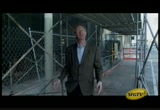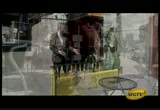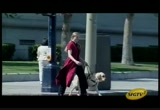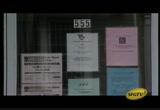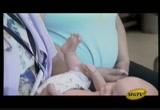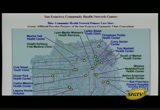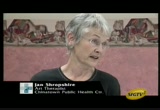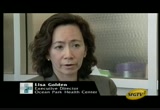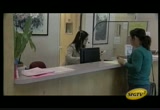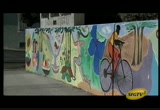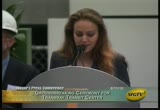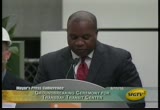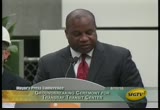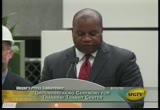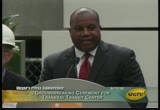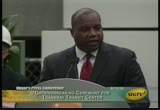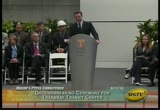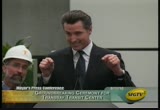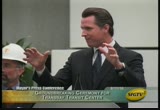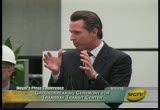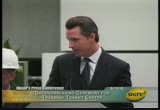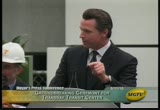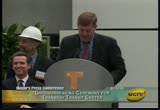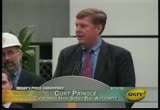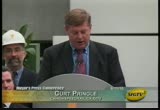tv [untitled] September 3, 2010 7:00pm-7:30pm PST
8:00 pm
smooth clean that nobody is going get caught up on. >> our no. 1 issue is what we see here, the uplifting and shreufting to concrete due too street tree roots. here is another problem we have with street trees. if i have i was a person blind, this would be an uncomfortable way to find out. >> we don't want to create hazards. >> sometimes vendors put sidewalk cafes where people push the chairs too far out.
8:01 pm
>> sometimes it can be impassable. so much foot traffic that there is no room for a wheelchair or walker to go by. >> san francisco is a lively street life, it can be an issue with people with visual disabilities as well. they have these diverting barriers on other side of this tables and chairs area. if people can find thraeur way around it without getting tangled up, it is still fully accessible. >> we don't want anything special. we want people to basically adhere to the regulations and laws as they are on the books now. people can also, just be
8:02 pm
cognizant if they have stuff on the street, they thaoed to have 48 inches so we can pass, think outside your own spectrum of yourself that there are other people you need to share the sidewalk with. we will all get along better. >> although san francisco is a hilly place for a whraoel chair user, we seem to be better at most. that doesn't mean we can't continue to improve upon ourselves. >> the public has a clear are -- of travel. we can't be every to make sure that is the place. we have to rely on the place. call 311. give them your name.
8:03 pm
that goes into a data base. >> it is difficult, still, um to make the case that the disabled community isn't being represented. in some ways we are not. we have a long way to go. >> the city of san francisco is using the most innovative technology available. these devices allow people to remain out in their communities, doing things like shopping. it is great to be able to walk as a pedestrian in this city and cross streets safely. when a resident of san francisco is looking for health care, you look in your neighborhood first. what is closest to you?
8:04 pm
if you come to a neighborhood health center or a clinic, you then have access it a system of care in the community health network. we are a system of care that was probably based on the family practice model, but it was really clear that there are special populations with special needs. the cole street clinic is a youth clinic in the heart of the haight ashbury and they target youth. tom woodell takes care of many of the central city residents and they have great expertise in providing services for many of the homeless. potrero hill and southeast health centers are health centers in those particular communities that are family health centers, so they provide health care to patients across the age span. . >> many of our clients are working poor.
8:05 pm
they pay their taxes. they may run into a rough patch now and then and what we're able to provide is a bridge towards getting them back on their feet. the center averages about 14,000 visits a year in the health clinic alone. one of the areas that we specialize in is family medicine, but the additional focus of that is is to provide care to women and children. women find out they're pregnant, we talk to them about the importance of getting good prenatal care which takes many visits. we initially will see them for their full physical to determine their base line health, and then enroll them in prenatal care which occurs over the next 9 months. group prenatal care is designed to give women the opportunity to bond during their pregnancy with other women that have similar due dates. our doctors here are family doctors. they are able to help these
8:06 pm
women deliver their babies at the hospital, at general hospital. we also have the wic program, which is a program that provides food vouchers for our families after they have their children, up to age 5 they are able to receive food vouchers to get milk and cereal for their children. >> it's for the city, not only our clinic, but the city. we have all our children in san francisco should have insurance now because if they are low income enough, they get medical. if they actually have a little more assets, a little more income, they can get happy family. we do have family who come outside of our neighborhood to come on our clinic. one thing i learn from our clients, no matter how old they are, no matter how little english they know, they know how to get to chinatown, meaning they know how to get to our clinic.
8:07 pm
85 percent of our staff is bilingual because we are serving many monolingual chinese patients. they can be child care providers so our clients can go out and work. >> we found more and more women of child bearing age come down with cancer and they have kids and the kids were having a horrible time and parents were having a horrible time. how do parents tell their kids they may not be here? what we do is provide a place and the material and support and then they figure out their own truth, what it means to them. i see the behavior change in front of my eyes. maybe they have never been able to go out of boundaries, their lives have been so rigid to sort of expressing that makes tremendous changes. because we did what we did, it
8:08 pm
is now sort of a nationwide model. >> i think you would be surprised if you come to these clinics. many of them i think would be your neighbors if you knew that. often times we just don't discuss that. we treat husband and wife and they bring in their kids or we treat the grandparents and then the next generation. there are people who come in who need treatment for their heart disease or for their diabetes or their high blood pressure or their cholesterol or their hepatitis b. we actually provide group medical visits and group education classes and meeting people who have similar chronic illnesses as you do really helps you understand that you are not alone in dealing with this. and it validates the experiences that you have and so you learn from each other. >> i think it's very important to try to be in tune with the
8:09 pm
needs of the community and a lot of our patients have -- a lot of our patients are actually immigrants who have a lot of competing priorities, family issues, child care issues, maybe not being able to find work or finding work and not being insured and health care sometimes isn't the top priority for them. we need to understand that so that we can help them take care of themselves physically and emotionally to deal with all these other things. they also have to be working through with people living longer and living with more chronic conditions i think we're going to see more patients coming through. >> starting next year, every day 10,000 people will hit the age of 60 until 2020. . >> the needs of the patients that we see at kerr senior center often have to do with the consequences of long
8:10 pm
standing substance abuse and mental illness, linked to their chronic diseases. heart failure, hypertension, diabetes, cancer, stroke, those kinds of chronic illnesses. when you get them in your 30's and 40's and you have them into your aging process, you are not going to have a comfortable old age. you are also seeing in terms of epidemics, an increase in alzheimer's and it is going to increase as the population increases. there are quite a few seniors who have mental health problems but they are also, the majority of seniors, who are hard-working, who had minimum wage jobs their whole lives, who paid social security. think about living on $889 a month in the city of san francisco needing to buy
8:11 pm
medication, one meal a day, hopefully, and health care. if we could provide health care early on we might prevent (inaudible) and people would be less likely to end up in the emergency room with a drastic outcome. we could actually provide prevention and health care to people who had no other way of getting health care, those without insurance, it might be more cost effectiti and >> good morning, everyone. in the director of the transbay joint powers authority. [applause]
8:12 pm
on behalf of the tjpa, i would like to welcome everyone to this historic occasion -- the groundbreaking of the first high-speed modern railway station in the united states. [applause] today marks the culmination of a very long journey and an enormous amount of hard work by many people to make this day a reality. there were many challenges along the way, but we had a great vision, a huge optimism, remained focused, and most importantly, have the ongoing support of the public to fulfill their expectations. here is what we are delivering to the public starting today. the first new high-speed rail station in the country, the first modern regional bus station in more than 60 years. after more than 100 years, a downtown san francisco train station, all line one modern landmark building designed by world-class architects and engineers.
8:13 pm
that will be surrounded by new residents and new workers. this will be a 21st century building for a 21st century region and state and a world- class building for a world-class city. i would like to extend a heartfelt thank you to all of our speakers today and also recognize the countless number of people across the san francisco bay area, california, and washington, d.c., who worked with us to make this happen. many are here today and others in spirit. thank you all. we made it. the grand central station of the west coast is starting construction. [applause] thank you. now, i would like to introduce our first speaker, the chairman of our board, nathaniel ford. he serves as the chair of the transbay joint powers authority and the executive director of the municipal transportation agency.
8:14 pm
he also sits on the caltrain board of directors. he has been a strong supporter of the project since its arrival, and we are deeply grateful for his leadership and guidance. chairman ford. [applause] >> thank you, maria. good morning, everyone. today is a great day, and we thank you for coming to our ceremony. i say our ceremony because it took all of us to pull this together, all of our hard work. those of you who contributed over the decade, a long effort to end at today culminating in a groundbreaking for our new transit center. there are many people that we should mention today and give a little bit of perspective in terms of how we got here, in which former mayor, joseph alioto, whose granddaughter is here today, which can be in one of the first studies of a future trends bay terminal -- future transbay terminal.
8:15 pm
more than a decade later, the recommendation was made to extend caltrain operations to the transbay terminal 1.3 miles away. after the earthquake in 1989, the terminal was determined to be unsafe. the city and state determined that the facility was seismically deficient. it was under former mayor brown who hired and placed his trust in our executive director, to lead transbay effort. she created and has led this transbay joint powers authority to design, build, and operate a facility which we stand today on the ground to break. a key milestone to bring us to this day was a transfer by the state of 12 acres of land to the tjpa and the city to help fund the new transit center. this agreement, signed during the brown administration and campaign at the state level by
8:16 pm
former senate president john burton -- [applause] that agreement provides one of the largest funding contributions to this project and allows for the creation of new neighborhoods with hundreds of affordable housing units. today, during the tenure of our mayor, gavin newsom, he has been an enthusiastic and effective advocate of the project since he was a supervisor representing district two. we finally break ground today. this project would not have been possible without the numerous contributions of individuals, and in particular, our transportation partners. the city and county of san francisco, the san francisco municipal transportation agency, the san detail transportation authority, the transit district, the metropolitan transportation commission, the state of california, our state legislative delegation, the
8:17 pm
california high speed rail authority, and the united states department of transportation, the federal transportation administration, the federal highway administration, and the federal railroad administration. we also have to thank president obama and secretary lahood. they deserve recognition for the recent $400 million in arra funding we have received. it is that funding and that a war that has propelled us into construction with the levels which will ultimately serve both caltrain and future high-speed rail. i also would like to thank the federal government for the 7 $1 million we have received as san francisco and tsa. we have used that to develop jobs that have created over 800 hours of job hours and also has allowed us to rank as the fourth leading agency in the nation for creating and retaining jobs. going forward, we will remain
8:18 pm
steadfast and committed to working with our federal partners to improve transportation and workforce opportunities in the bay area. in that same vein, i would also like to thank acknowledge our congressional delegation, speaker pelosi, senator feinstein, senator boxer, congressman miller. [applause] is through their hard work and their contribution that we have been able to get to this day and have a successful transbay project. thank you very much. >> thank you, mr. chairman. now, it gives me great pleasure to welcome the mayor of san francisco. mayor newsom has led the way in creating jobs and stimulating the city put the economic growth. under his leadership, san francisco has become a hub for clean technology, renewable
8:19 pm
energy, and green development. during his tenure, development progressed through the planning stages to the start of construction. we thank our mayor for his strong support of the project and for all his guidance. >> thank you all. welcome. a small crowd for san francisco. this is rather extraordinary. that did all the thank you's. god forbid that i repeat every single name he mentioned. we have another six or seven speakers coming up. but i do want to get to the banks after it was not long ago, and it is in distant memory, in the 1990's, we saw a huge economic growth in the bay area, not just here in san francisco. we had growth in 15% of our employment base, but we found something alarm or remarkable.
8:20 pm
it was about the time that steve came forward with that mtc report that showed it some likely scenarios that might need to be adjusted slightly. in the next 25 years, we expect to grow to another 1.2 million people. the question at the time, and again today, what do you do to accommodate that growth? how do you compete? we had to think differently. we are blessed because one of the things we are celebrating is the visionary leadership of leaders that have come and gone, establishing a framework for transportation, recognizing
8:21 pm
that than today with transit, near and around jobs, we will continue to grow, we have to prosper. this is the ultimate manifestation of smart growth. the first and substantive thing we are doing is this $1.2 billion transit center that links 11 transit agencies. the second thing we are celebrating a is a brand new neighborhood. 2600 housing units, 35% of them below market, 3 million square feet of commercial space.
8:22 pm
when we get done with this, we will be talking about not just the transamerica icon, the golden gate bridge, the new span on the bay bridge, but a new icon intent to go in and around the world. the tallest new tower on the west coast of the united states that will anger this neighborhood with real focus on street level vibrancy, outdoor cafes, expanded sidewalks, tree- lined boulevards, outdoor merchants. connecting a sense of community with a sense of place. the third thing we are celebrating, live near pringle is here, we are going to be building a box. we are building a box that will
8:23 pm
accommodate something that is arguably a generation overdue. i am sick and tired of hearing how wonderful the transportation system is in france, do you know what they're doing in beijing? finally, california will get it right in with this. this project that so many people have talked about will finally start to take shape. the fourth thing we are celebrating go to my first point, leadership. stewardship. we would not be here if it was not the work for willie brown and others. don perotta and his
8:24 pm
extraordinary work. members of the board of supervisors that have come and gone. past mayors, incredible leadership from caltran, mtc, to all the folks that you see here, and in particular, secretary ray lahood, who stepped up to the plate and follow through on a commitment to steer a significant amount of funds our way. to barbara boxer as well, who has proven it is not just words that create jobs, but follow- through. it is about the leadership and the extension of past mayors, the good work of george miller, all the folks that that in four dimensions. let me conclude by saying that at the end of the day, all of
8:25 pm
that matters a lot come but it is simply not enough. the only way to cross the finish line, the only reason that we will be back here in 2017 completing -- celebrating its completion, it is all because there was a member of the congress to ended up becoming the speaker of the house, nancy pelosi. her faith to this project, we are really celebrating her and her delegation. there is a guy with a hat on behind me. mike represents the building traders there is a lot of reason to be happy about what this project represents, but now more than ever, the job it -- the
8:26 pm
issue is jobs. that is also what we are celebrating. tens of thousands of jobs that will begin anew with the demolition and reconstruction. and that is something to celebrate. thank you for being here. [applause] >> thank you, mr. mayor. now i would like to introduce major spring goal in the chair of the california high speed rail authority, one of the collaborators on the project. anaheim mayor kurt pringle was appointed to the border by governor schwarzenegger. he took over as chairman one year ago and has helped us usher in a new phase, winning the largest share of federal act funds in the country, hiring a new ceo, and moving the plan to implementation. he is a former speaker of the
8:27 pm
california state assembly and had been the mayor of anaheim since 2002, which to the south of where we are today, is where the rail system will terminate. mayor pringle. [applause] >> thank you. i did notice willie brown showed up when i came to the podium. [laughter] mr. mayor, it is so nice to be in your city. as you are getting ready to break ground on this project, i, too, and looking for to breaking ground on a major transit center. major new some, i do not believe
8:28 pm
that that is the only similarity we share. we are both committed to delivering a high speed rail system to california. this breaking of brown them in great -- demonstrates the breaking of that system. in anaheim, we will break ground next here on our regional intermodal train that center. this type of project takes a tremendous amount of vision and leadership to follow through. of course, san francisco is a city with a long tradition of leadership and vision. projects like these, if done right, have the power to transform a city and to transform the quality of life for so many citizens who can change the way that they travel to and from work, to a city, or to a region for a long weekend.
8:29 pm
at the end of the day, transportation is about moving californians efficiently so that they could spend more time, not in traffic, but with their family and friends and doing things they enjoy. for most of us, that is spending a week in san francisco. that is the name of the california high-speed rail project, to move as efficiently and affordably from one metropolitan of our state to another. although the california high- speed rail project will not be selling tickets from los angeles to san francisco for another 10 years, the transbay joint powers authority inc. the need for trains in other cities. we are glad they have considered the future development of a high-speed system. we are a
56 Views
IN COLLECTIONS
SFGTV2: San Francisco Government Television Television Archive
Television Archive  Television Archive News Search Service
Television Archive News Search Service 
Uploaded by TV Archive on

 Live Music Archive
Live Music Archive Librivox Free Audio
Librivox Free Audio Metropolitan Museum
Metropolitan Museum Cleveland Museum of Art
Cleveland Museum of Art Internet Arcade
Internet Arcade Console Living Room
Console Living Room Books to Borrow
Books to Borrow Open Library
Open Library TV News
TV News Understanding 9/11
Understanding 9/11